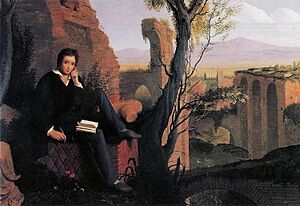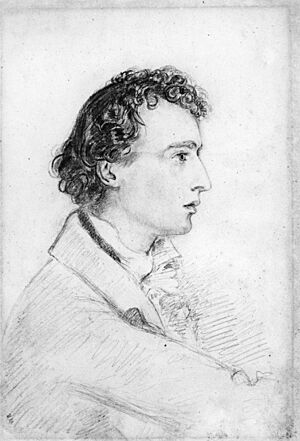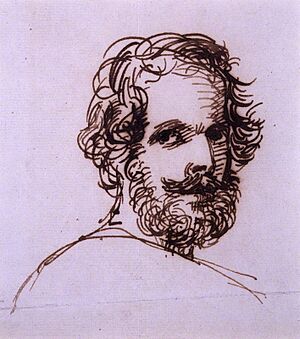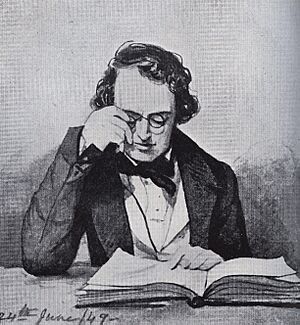Joseph Severn facts for kids
Joseph Severn (born December 7, 1793 – died August 3, 1879) was an English painter. He was known for his portraits and other types of paintings. Joseph Severn was also a close friend of the famous English poet John Keats. His paintings can be seen in important museums in London, like the National Portrait Gallery and the Victoria and Albert Museum.
Contents
Early Life and Artistic Beginnings
Joseph Severn was born in Hoxton, near London. He was the oldest of seven children. His father was a music teacher, and Joseph himself was a skilled piano player. When he was 14, he started training with William Bond, an engraver. In his early years, he focused on painting small portraits.
Becoming a Royal Academy Artist
In 1815, Joseph Severn joined the Royal Academy Schools in London. This was a big step for his art career. He showed his first oil painting, Hermia and Helena, in 1819. He also displayed a small portrait of J. Keats, Esq. He likely met the poet John Keats around 1816.
In 1819, Severn won a special gold medal from the Royal Academy. He earned it for his painting Una and the Red Cross Knight in the Cave of Despair. This painting was inspired by a long poem called The Faerie Queene. It was the first time this award had been given in eight years! Winning this medal meant Severn could apply for a three-year trip to study art, paid for by the Royal Academy.
Journey to Italy with John Keats

On September 17, 1820, Joseph Severn sailed from England to Italy. He traveled with the famous poet John Keats. They knew each other, but they weren't very close friends yet. Severn agreed to go with Keats to Rome when no one else could. Keats hoped the warm climate would help his illness, which he thought was tuberculosis.
After a difficult journey, they arrived in Italy in October. They had to stay in quarantine for ten days. Then they traveled to Rome, arriving in mid-November 1820. In Rome, they lived in an apartment at 26 Piazza di Spagna. This spot was right near the famous Spanish Steps.
Caring for a Friend
Severn had left England without his father's approval and with little money. His father was very angry about his departure, and they never saw each other again. While in Rome, Severn wrote many letters to friends in England about Keats. These letters are now very important. They are the only detailed record of Keats's last few months.
Severn took care of Keats until the poet passed away on February 23, 1821. This was three months after they arrived in Rome. Keats himself recognized Severn's great care. He said, "Severn I can see under your quiet look -- immense twisting and contending -- you don't know what you are reading -- you are enduring for me more than I'd have you -- O! that my last hour was come --" The poet Percy B. Shelley later thanked Severn for his devotion. During this time, Severn also met other important people, including sculptors John Gibson and Antonio Canova. He also met Lord Byron's friend, the adventurer Edward John Trelawny.
Life and Art After Keats
Many people used to think that Severn's life was mostly defined by his friendship with Keats. However, Severn became a very successful artist on his own after Keats died. He painted many different types of art in Rome during the 1820s and 1830s. He created small portraits, large church paintings, landscapes, and scenes from history and the Bible. He also painted subjects from Greek mythology and Shakespeare.
His paintings of Italian village life became very popular with British visitors. Many people asked him to paint for them. Severn also helped start the British Academy of Arts in Rome. This academy was supported by important people like the Duke of Devonshire. Severn's apartment became a busy center for the Academy.
Return to England and Later Career
When Severn returned to England in 1841, he faced financial difficulties. He worked hard to earn money by painting portraits to support his growing family. Even though he didn't have the same artistic success in England as he did in Rome, he still showed 53 paintings at the Royal Academy in London between 1819 and 1857.
In 1861, Severn was appointed the British Consul in Rome. This was during a time when Italy was becoming a unified country. Rome was still controlled by the Pope, who had French troops helping him. Severn's job was to represent Britain. He often helped British visitors in Rome. He also used his position to help Italian political prisoners. His friendly nature and knowledge of Italian helped him work with the Pope's government and the British government. He retired as Consul in 1872.
Family Life
In 1828, Joseph Severn married Elizabeth Montgomerie. They had seven children together. Three of their children became well-known artists. These were Walter, Arthur Severn, and Ann Mary Newton. Mary had a successful painting career in England. She even painted portraits for the Royal Family. Her early death at age 32 deeply affected her father. In 1871, Arthur Severn married Joan Ruskin Agnew, who was a cousin of the famous art critic John Ruskin.
Death and Legacy
Joseph Severn passed away on August 3, 1879, at 85 years old. He was buried in the Protestant Cemetery in Rome, right next to John Keats. Their gravestones are still there today. Other famous poets like Shelley are also buried in the same cemetery.
Famous Paintings by Joseph Severn
Severn is most famous for his many portraits of John Keats. Some of these include:
- A small portrait in The Fitzwilliam Museum (1819).
- A sketch called Keats on his Deathbed (1821) at the Keats-Shelley house in Rome.
- An oil painting of the poet reading, John Keats at Wentworth Place (1821–23), at the National Portrait Gallery.
- A later painting, Keats, at Hampstead, when he first imagined his Ode to a Nightingale (1849), at Keats House.
Severn also painted other important works:
- The Vintage (1825), for the Duke of Bedford.
- The Fountain (1826), for Leopold I of Belgium. This painting might have influenced a famous work by J. M. W. Turner.
- Rime of the Ancient Mariner (1839), based on Samuel Coleridge's famous poem.
- The Abdication of Mary, Queen of Scots, a historical painting.
He also painted:
- Cordelia Watching by the Bed of Lear
- Shepherds in the Campagna
- Shelley Composing Prometheus Unbound
- Isabella and the Pot of Basil
- Portia with the Casket
- Ariel
- Rienzi
- The Infant of the Apocalypse Saved from the Dragon (a large church painting)
- Many portraits of important people, including Baron Bunsen and William Gladstone.
The last painting he showed at the Royal Academy was a scene from Oliver Goldsmith's The Deserted Village in 1857.
|
More About Joseph Severn
Several books have been written about Joseph Severn's life and work:
- In 1892, William Sharp published The Life and Letters of Joseph Severn.
- In 1965, Sheila Birkenhead wrote Illustrious Friends: The story of Joseph Severn and his son Arthur.
- In 2005, Grant F. Scott published Joseph Severn: Letters and Memoirs. This book included many new letters and pictures of Severn's paintings.
- In 2009, Sue Brown wrote a biography called Joseph Severn, A Life: The Rewards of Friendship. This book used the new information from Scott's work to share more about Severn's personality, his friendship with Keats, and his own career as an artist and diplomat.
Links to images and descriptions of Severn's drawings and paintings
- A slideshow of paintings by Severn on the Art UK website
- Portraits by Severn at the National Portrait Gallery, London
- The Infant of the Apocalypse Saved from the Dragon at Tate Britain, London
- Ariel at the Victoria and Albert Museum, London
- Ariel: 'Where the Bee Sucks... at the Victoria and Albert Museum, London
- Keats on his Deathbed at the Keats-Shelley house, Rome
- Severn's original miniature of Keats, painted in 1819 at The Fitzwilliam Museum, Cambridge
- Supposed portrait of Keats, attributed to Severn at The New Art Gallery, Walsall
- Portrait of John Crossley of Scaitcliffe at the Christchurch Art Gallery, Christchurch, New Zealand
- Ariel riding on a Bat at the Ashmolean Museum, Oxford
- Sketches by Severn at Wake Forest University, North Carolina
See also
 In Spanish: Joseph Severn para niños
In Spanish: Joseph Severn para niños





